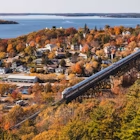
‘Over there!’ someone shouts, pointing to the water a few boat lengths away. You hear a ‘whoosh’, see a spout of mist, and suddenly the barnacled behemoth appears. It steams through the waves for a quick game of hide and seek. Then its tail flukes arch up, water cascades from the scalloped edges, and it disappears into the depths.
A real-life encounter with whales is an unforgettable experience, and with more than 30 species roaming the waters off its 202,000km of coastline, is prime territory for chasing whale tail. Get up close and personal with camera hogs like the humpback, known for launching its 36-tonne body up and out of the water for playful breaching; the endangered North Atlantic right whale, with an estimated population of just 350; the blue whale, the largest animal on earth at 25m and 100 tonnes; and the little minke, which often approaches boats and shows off with acrobatics. Launch your exploration from a range of viewing hotspots offering boat, kayak or even snorkel trips.
East coast
The Atlantic holds the whale jackpot, with more than 20 species lurking offshore and plenty of places to take to the waters.
Tadoussac, Quebec
In a nifty feat of geography, the warm, fresh waters of the Saguenay River jet out atop the frigid, salt waters of the St Lawrence River, churning up massive volumes of krill. Humpbacks, minkes and blue whales swim in to feast, as do chatty white belugas, which are otherwise seen only in the Arctic. Zodiac boats are the prime way to meet the beasts. You'll need to don warm coveralls and hang on for a wild, wind-in-your-hair ride over the waves – all totally worth it when you're close enough to smell a whale's breath. Peak season: May to mid-October, especially August and September when blues whales congregate. Average cost: $65 per two-hour tour.
Digby Neck, Nova Scotia
This spit of land juts into the Bay of Fundy, home to the planet's most extreme tides. The roiling water stirs up serious quantities of fish and krill, drawing hungry whales like Homer Simpson to doughnuts. Finbacks, humpbacks and minkes are commonly seen chowing down, and the bay is the best place to glimpse the uber-rare right whale. Zodiacs and larger boats set sail from local docks; many double as research vessels, with biologists on board who conduct whale studies during the watch. Peak season: mid-July to mid-September. Average cost: $60 per three-hour tour.
Witless Bay, Newfoundland
Whales cavort everywhere around the island of , but Witless Bay Ecological Reserve, 35km south of the capital , goes beyond the norm. Humpbacks and minkes are just part of the story – the four-island sanctuary is also home to millions of flapping, shrieking, rare seabirds, plus glistening icebergs drift by in early summer. While tour boats depart along the coast, kayaking is the way to go. You don't just see a whale while paddling: you feel its presence. Peak season: late June to August. Average cost: $60 per two-hour tour.
Cape Breton Highlands, Nova Scotia
Forested Cape Breton Highlands is one of the premier places to view whales from shore, though they're likely to be pilot whales, a smaller kind. The region's scenic roads and hiking trails provide infinite pull-offs for spout-filled vistas. Catamarans and Zodiacs zip out from highland villages for those in search of bigger fry, like finbacks and humpbacks. Peak season: July and August. Average cost: $50 per two-hour tour.
West coast
Humpbacks and grey whales patrol Canada's west coast, but it’s the orca that dominates viewing here.
Robson Bight, British Columbia
To 's north, Robson Bight Ecological Preserve is Canada's only killer whale sanctuary, where some 200 orcas converge to play. If you want your whales bursting from a misty, primeval environment, this is it. Boats depart from lonely Telegraph Cove, using underwater microphones to track the speedy (up to 40km/h) carnivores. Peak season: mid-June to October. Average cost: $100 per three-hour tour.
Tofino, British Columbia
Each winter 20,000 grey whales leave the Baja Peninsula and haul their bus-size bodies north to , cruising right past en route. They swing in close to shore, so even landlubbers can see the action. Zodiacs and kayaks provide a thrill ride to the pods that spend summer in nearby Clayoquot Sound. Peak season: the migration peaks in late March, but whales are around until mid-October. Average cost: $90 per 2¬Ω-hour tour.
North coast
Belugas glide in Arctic waters. The ghostly white whales are small, measuring just 4m, and talkative, squeaking to one another amid the ice cubes.
Churchill, Manitoba
When you tire of the famed polar bears at Hudson Bay, arrange a boat or kayak trip to commune with the resident belugas. Hard-core types can shimmy into a mega-thick wetsuit and snorkel with them. Peak season: July and August. Average cost: $200 per three-hour tour.
Whale-watching tips
Tour operators often post sighting success rates, but if not ask (and ask if there's any sort of money back guarantee if you don’t see whales).
You’re heading out on open sea for many of the tours, so prepare for a wavy ride. If you're prone to seasickness, medicate beforehand.
Don’t forget to bring warm clothes, sunblock and binoculars.
This article was published in January 2013 and updated in April 2013.
Explore related stories



 Budget TravelAnchorage on a budget: Big Alaska experiences on a smaller bankroll
Budget TravelAnchorage on a budget: Big Alaska experiences on a smaller bankrollDec 13, 2024 • 8 min read
 Wildlife & Nature9 things you need to know before visiting beautiful and quirky Anchorage
Wildlife & Nature9 things you need to know before visiting beautiful and quirky AnchorageDec 10, 2024 • 8 min read



 Sustainable TravelCanada's 4 best train trips offer big country adventures
Sustainable TravelCanada's 4 best train trips offer big country adventuresNov 20, 2024 • 10 min read


